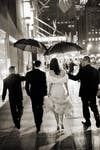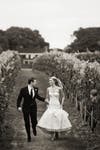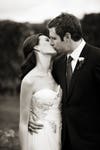Tips From a Pro: Photographing a Wedding
Professional wedding photographer Christian Oth let's us in on the secrets to making incredible wedding photos

If you’re a photographer, sooner or later you’ll be tapped by friends or family to shoot a wedding. But how do you get amazing photos? We asked renowned wedding shooter Christian Oth to tell us how he does it, and to give us hints on how to handle the most challenging parts of the wedding day._
Despite starting out as a second photographer for a wedding shooter who didn’t think he was good enough to be a first, Christian Oth, now 43, has an extremely successful career running his own New York City-based wedding studio. Our sister magazine American Photo has named him one of the top 10 wedding photographers, and his work has been featured in, among others, New York magazine, Martha Stewart Weddings, and The New York Times Magazine.
Describe your style.
Unscripted. But it’s mostly photojournalistic, with a bit of fashion photography mixed in. I try not to interrupt the wedding or events throughout the day too much. How do you anticipate the best moments? The ability to predict them comes mostly from experience. One key moment to be there for: When a bride steps into her dress, more often than not her dad comes into the room soon after, usually just before she leaves for the ceremony to walk her down the aisle. Sometimes I’m in another room photographing another detail shot, but I always want my assistant to let me know when her dad will be coming in.
What’s the best way to set your cameras?
Always have one ready that’s just set for quick snaps. Keep it on P—for Professional! For those shots, I use a Canon EOS 5D Mark II with a 24–70mm lens. I try to use flash as little as possible, but sometimes I’ll mount a flash on it. I mainly shoot with a Canon EOS-1Ds Mark III—that’s my first camera and my “fine art” camera. I also carry lots of prime lenses: A 35mm f/1.4 and 50mm f/1.2, a 24mm f/1.4, and a 85mm f/1.2—all for different situations. I shoot a lot with the 35mm and 50mm. Those are great for details and bridal portraits.
How can you carry all that stuff?
My assistant wears a backpack. I carry the 1Ds, 5D, and three other lenses in a pouch that I sling over my shoulder. I find this the most comfortable way to work; I can exchange lenses very quickly.
What are the most important things to shoot, besides the couple?
There are always certain details that I come back with. I take a picture of the dress, the shoes, the outside of the buildings where the events take place, and details of the event and the locale. The bridal suite, accessories, and bouquet are key, too.
I always mention this to brides: Make sure that the bouquet is in the bridal suite. It’s not a given that it will be where she’s getting ready—sometimes it’s at the church, for example. But I try to do the bridal portraits beforehand and it’s good to have the flowers there. And get help keeping the room clean! You have no idea how many rooms I’ve been in that were completely messy, and I didn’t know where to point my camera.
What’s the best time to shoot reception still lifes?
Toward the end of the cocktail hour. We usually work in teams of two: One works the cocktail hour and gets the people interacting—that’s when we photograph most of the guests. During a typical wedding I spend half the cocktail hour photographing the bride and groom and doing portraits, then I go to the reception space and get all the décor shots. The best time to do that is about 15 minutes before they let the people in—that way there’s water in the glasses and the candles are lit. I try to get shots of people walking in, too.
I do long exposures as people are sitting down. I spend a lot of time on this—15 minutes during a wedding day is a long time. Most I shoot on a tripod on the lowest ISO possible. My assistant helps me—we bring in a little video light to highlight details, a Frezzi by Frezzolini. They’re great, very simple and durable. We use them with Bescor batteries, which are also very small—you can clip them to your belt. I sling the light over my neck and if I need it, I use it myself or have my assistant hold it.
How much CF-card memory do you need?
I bring about 150GB, but I don’t usually fill them all up. I shoot a 32GB card as my last card of the day. Knock on wood, I’ve never had a card go bad.
What lighting gear do you recommend?
I use a Profoto Pro 600B lighting pack—I can really dial it down but it has 600Ws of power if I need it. I’m always in favor of less equipment. Sometimes I don’t even bring that light. You can do a lot with camera flash, especially when it’s an outdoor wedding and all you need is fill. Sometimes I bring a second light or an octobank—if I have more than one assistant. When the gear gets more complex, you have to deal with logistics, and I shy away from that as much as I can.
How much time should you spend with the couple to make sure you get something good?
That depends on the couple. It starts at five minutes—give me five minutes and I can get great portraits. I’ve dealt with way too many weddings where everything is running too late and the couple session gets nixed, but I have to put my foot down: We have to do it. On average, I spend about 20 minutes to half an hour. You’ve got to have a picture of them looking at the camera, kissing, looking at each other in an interesting or romantic setting—I can do that very quickly.
How do you get such a naturalistic look?
By putting couples into natural situations where they feel most comfortable. My goal is to get them to engage with one another. A lot of times I’ll tell them: “Wouldn’t it be great if you…” and then I make a suggestion, like running through a field. Afterward they are in a happy moment, and that’s when you often get great pictures. In these photos are so many genuine moments that I didn’t create—I was just there for them.

Rain can’t spoil a wedding on New York’s Park Avenue.

It’s always important to explore the property where the wedding is taking place.

Shooting the bride backlit by a window lends an etherial look.

Don’t forget to get the couple kissing.

A great shot of the recessional is key.

Oth avoids flash when he can, as in this reception image, shot at ISO 400 and f/1.4.

Oth caught these little girls watching the bride and groom.